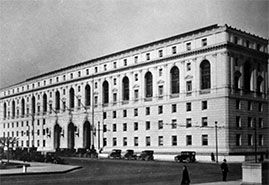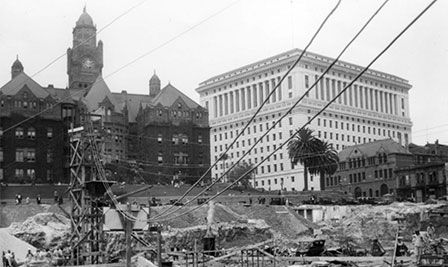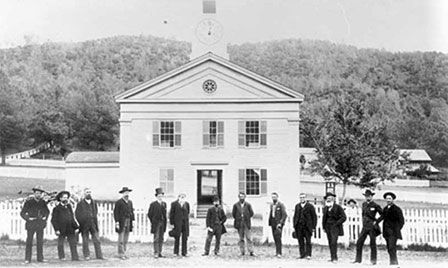Understanding the Golden State’s Criminal
Justice System
California’s Criminal Justice system is responsible for providing public safety by deterring and preventing crime, punishing offenders, and reintroducing those who have served their time back into the community. The criminal justice system is based on the body of laws that define crimes and offenses, and specify what punishments are appropriate for those crimes.
There are three types of crimes that are defined by California State law: felonies, misdemeanors, and infractions.
Governor jerry brown signs senate bill 42 in 1976.- Felonies are usually the most serious crime. An individual that is convicted of a felony may face jail time, though that time may be spent in either a county jail, or a state prison. Felonies cover crimes that are considered both serious, and/or violent. Commonly known felonies include murder, robbery, rape, burglary of a residence, and assault. Felony punishments vary in harshness depending on the nature of the crime, discretion of the court, and the offender’s criminal history.
- A misdemeanor is typically a less serious crime, and common punishments include probation, county jail time, fines, or a combination of all three. Common misdemeanors include assault, theft, and public drunkenness.
- An infraction is the least serious crime and is nearly always punished with a fine. Nearly all infractions are crimes committed while operating a motor vehicle, and include speeding, and inappropriate parking.
California law also defines certain crimes as “wobblers” or offenses that fall under one type of law but are charged as a different type of law, such as a misdemeanor that is charged as a felony.
 Governor Jerry Brown speaking about determinate sentencing in 1976. Photo by Tony Korody/Sygma via Corbis.
Governor Jerry Brown speaking about determinate sentencing in 1976. Photo by Tony Korody/Sygma via Corbis.
Determinate Sentencing went into effect in California in 1976, and enacted a new sentencing structure for felonies. Under this structure, felony punishments have a defined release date based on three different options, or a “triad” sentencing structure. A first-degree burglary, for example, can be punished by either a two, four, or six year sentence. Based on the circumstances surrounding the offense, the court can raise, or lower the punishment within these parameters.
There are still punishments carried out under Indeterminate Sentencing, but these are usually reserved for the most serious crimes, such as first-degree murder.
California’s Criminal Justice System has a four stage processing structure. Those four stages are the commission of the crime, arrest by law enforcement, prosecution of a case in court, and detention and supervision by corrections agencies.
- The process begins with a crime, which can be felonies, misdemeanors, or infractions. In 2011, 1.1 million crimes were reported as being committed by either adults or juveniles.
- The arrest occurs when city police or county sheriff's detain an individual who is suspected of committing a crime. Those arrestees are kept in county jails or released on bail. Of the 1.1 million reported crimes in 2011, 420,000 resulted in an arrest.
- The third stage is prosecution, where cases are heard in criminal courts. Offenders are usually prosecuted by country district attorneys, while the offenders defense is either provided by the state with county public defender's or private attorneys. Of the 420,000 arrests in 2011, 240,000 ended with felony cases that were decided and sentenced.
- The final stage is corrections, and represents the punishment to be handed out for the crime. The sentence is determined by the age of the offender, the severity of the crime, and the discretion of the court. Adults may serve time in county jail, undergo community supervision, pay fines, stay in state prison, or face any combination of these punishments. Juveniles can be supervised by county probation in facilities or in the community or sent to state juvenile facilities or state prison.
 The first courthouse in San Francisco at 640 Clay Street in 1874. The courthouse would serve as the center for justice in San Francisco until 1881. In the back are masts of ships anchored in the bay.
The first courthouse in San Francisco at 640 Clay Street in 1874. The courthouse would serve as the center for justice in San Francisco until 1881. In the back are masts of ships anchored in the bay.
After a crime is committed and reported to the authorities, the alleged offender(s) are arrested by law enforcement officers. The majority of arrests are for misdemeanor offenses. Of the 166,588 crimes reported in 2015, the majority were committed by adults, and were non-violent. California state sentencing laws are primarily enforced at the local level by country sheriffs and city police, but the state does have a limited role in law enforcement. The California Highway Patrol has a smaller number of officers to ensure safety and enforce traffic laws, but they do provide law enforcement for crimes committed on state highways and country roads. The state also provides law enforcement for state-run areas such as state parks and college campuses. The California Department of Justice provides expertise to local police and sheriffs in the investigation of crimes that exceed local jurisdiction, also known as multi-jurisdictional crimes. One example of such a situation is widespread organized crime.
Once arrested, an individual may be charged with committing a crime. They then must go through California’s trial court system to determine a final verdict. Trial courts are funded by the state, though local governments are responsible for providing district attorneys and public defenders. Including all types of criminal cases, there were over 8 million filings in California trial courts in 2009 to 2010. Of those, only a few hundred thousand of these are felonies committed by adults, and of those adult felonies, around 80 percent result in a guilty verdict. Federal criminal law is limited to the powers of the federal government laid out in the constitution. Because of this, most federal criminal laws adhere to the federal government’s role in the regulation of interstate commerce, immigration, and the protection of federal facilities and personnel. As a result, federal law enforcement and prosecutions tend to focus on non-violent crime like drug trafficking, immigration issues, fraud, bribery, and extortion.
A brief documentary of the California court system.The final component of the criminal justice system is commonly known corrections. In California, adults convicted of a felony are usually placed under the supervision of a corrections facility.
These facilities are known at the local level as jails, and at the state level as prisons. Offenders that do not serve jail times but still have restrictions placed upon them are undergoing probation at the local level, and parole at the state level. The time an offender must serve in the corrections program is determined by the severity of their crime. Most felony offenders serve time at local corrections agencies, while a smaller number of more serious or violent offenders are supervised at the state level.
 The present day center of criminal justice in San Francisco, first established in 1923, at 350 McAllister Street.
The present day center of criminal justice in San Francisco, first established in 1923, at 350 McAllister Street.
California’s court system is the largest in the United States, and is generally proportionate to the states population in comparison to the countries. Serving nearly 40 million people, it represents around 11 percent of the national population, 10 percent of the jail population, 12 percent of the prison population, and 14 percent of the parole population. The only disproportionate percentage represented by California is their probation population, which only accounts for seven percent of the U.S. population. The growth rate of California’s probation and jail populations were lower than other states, but their prison and parole population growth rate was higher. In terms of expenditures, California spends the second most per capita on corrections and has the second highest paid correctional officers, but only spends the sixth most per prisoner.
When ranked against other states for number of probationers per 100,000 citizens, California ranked 36th with only 1,047 probationers, 38 percent below the national average. It’s prison incarceration rate, however, is slightly higher than the national average, with 439 per 100,000 compared to the national average of 437, which ranks it at the 20th largest in this category. Parole is also higher than the national average, with 376 per 100,000 over the national average of 312, ranking California at number 11.
 Hall of Justice in 1927, with work proceeding in a nearby quarry that would soon be the Los Angeles City Hall. Behind and to the left stands the old County.
Hall of Justice in 1927, with work proceeding in a nearby quarry that would soon be the Los Angeles City Hall. Behind and to the left stands the old County.
 Mariposa County Courthouse with 13 county officials. Taken in the 1880s.
Mariposa County Courthouse with 13 county officials. Taken in the 1880s.
The first criminal courts in California were authorized in 1924, which permitted the establishment of municipal courts in cities and counties that had populations of over 40,000 citizens. The first municipality to establish a criminal court was Long Beach, when they established their court with 5 judges in 1925. Just 5 months later, Los Angeles followed suit with a court of 24 judges. San Francisco would introduce their 12 judge court five years later in 1930, with other municipalities introducing their own courts as needed to modern day. Long Beaches Courthouse has since been demolished, but the Los Angeles courthouse, known as the Hall of Justice, still exists today. While it remained shuttered after sustaining damage in the Northridge Earthquake of 1994, it was reopened in 2014. The oldest courthouse in California is the Mariposa County Courthouse, which was founded during the California Gold Rush in 1851. While it is not founded as a municipal courthouse, its role was important in establishing law in California, and dealt mostly with mining law in its early days.
